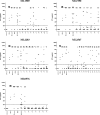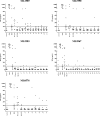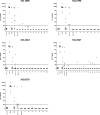Rational combination of peptides derived from different Mycobacterium leprae proteins improves sensitivity for immunodiagnosis of M. leprae infection
- PMID: 18199740
- PMCID: PMC2268264
- DOI: 10.1128/CVI.00432-07
Rational combination of peptides derived from different Mycobacterium leprae proteins improves sensitivity for immunodiagnosis of M. leprae infection
Abstract
The stable incidence of new leprosy cases suggests that transmission of infection is continuing despite the worldwide implementation of multidrug therapy programs. Highly specific tools are required to accurately diagnose asymptomatic and early stage Mycobacterium leprae infections which are the likely sources of transmission and cannot be identified by using the detection of antibodies against phenolic glycolipid I. One of the hurdles hampering T-cell-based diagnostic tests is that M. leprae antigens cross-react at the T-cell level with antigens present in other mycobacteria, like M. tuberculosis or M. bovis bacillus Calmette-Guerin (BCG). Using comparative genomics, we previously identified five candidate proteins highly restricted to M. leprae which showed promising features with respect to application in leprosy diagnostics. However, despite the lack of overall sequence homology, the use of recombinant proteins includes the risk of detecting T-cell responses that are cross-reactive with other antigens. To improve the diagnostic potential of these M. leprae sequences, we used 50 synthetic peptides spanning the sequences of all five proteins for the induction of T-cell responses (gamma interferon) in leprosy patients, healthy household contacts (HHC) of leprosy patients, and healthy controls in Brazil, as well as in tuberculosis patients, BCG vaccinees, and healthy subjects from an area of nonendemicity. Using the combined T-cell responses toward four of these peptides, all paucibacillary patients and 13 out of 14 HHC were detected without compromising specificity. The peptides contain HLA binding motifs for various HLA class I and II alleles, thereby meeting an important requirement for the applicability of diagnostic tools in genetically diverse populations. Thus, this study provides the first evidence for the possibility of immunodiagnostics for leprosy based on mixtures of peptides recognized in the context of different HLA alleles.
Figures






Similar articles
-
HLA and leprosy in the pre and postgenomic eras.Hum Immunol. 2006 Jun;67(6):439-45. doi: 10.1016/j.humimm.2006.03.009. Epub 2006 Apr 3. Hum Immunol. 2006. PMID: 16728267 Review.
-
Immune profiling of leprosy and tuberculosis patients to 15-mer peptides of Mycobacterium leprae and M. tuberculosis GroES in a BCG vaccinated area: implications for development of vaccine and diagnostic reagents.Immunology. 2004 Apr;111(4):462-71. doi: 10.1111/j.0019-2805.2004.01839.x. Immunology. 2004. PMID: 15056384 Free PMC article.
-
A systematic molecular analysis of the T cell-stimulating antigens from Mycobacterium leprae with T cell clones of leprosy patients. Identification of a novel M. leprae HSP 70 fragment by M. leprae-specific T cells.J Immunol. 1991 Nov 15;147(10):3530-7. J Immunol. 1991. PMID: 1940353
-
Immunogenicity of Mycobacterium leprae unique antigens in leprosy endemic populations in Asia and Africa.Lepr Rev. 2011 Dec;82(4):445-58. Lepr Rev. 2011. PMID: 22439283
-
Recent advances in immunodiagnosis of leprosy.Indian J Lepr. 2007 Apr-Sep;79(2-3):85-106. Indian J Lepr. 2007. PMID: 18085168 Review.
Cited by
-
ML Flow serological test: complementary tool in leprosy.An Bras Dermatol. 2023 May-Jun;98(3):331-338. doi: 10.1016/j.abd.2022.05.005. Epub 2023 Mar 6. An Bras Dermatol. 2023. PMID: 36890048 Free PMC article.
-
Immunologically reactive M. leprae antigens with relevance to diagnosis and vaccine development.BMC Infect Dis. 2011 Jan 26;11:26. doi: 10.1186/1471-2334-11-26. BMC Infect Dis. 2011. PMID: 21269435 Free PMC article. Clinical Trial.
-
Integrative immune analysis in patients with leprosy reveals host factors associated with mycobacterial control.EBioMedicine. 2025 Aug;118:105855. doi: 10.1016/j.ebiom.2025.105855. Epub 2025 Jul 18. EBioMedicine. 2025. PMID: 40683203 Free PMC article.
-
Pathogen-specific epitopes as epidemiological tools for defining the magnitude of Mycobacterium leprae transmission in areas endemic for leprosy.PLoS Negl Trop Dis. 2012;6(4):e1616. doi: 10.1371/journal.pntd.0001616. Epub 2012 Apr 24. PLoS Negl Trop Dis. 2012. PMID: 22545169 Free PMC article.
-
T-cell regulation in lepromatous leprosy.PLoS Negl Trop Dis. 2014 Apr 10;8(4):e2773. doi: 10.1371/journal.pntd.0002773. eCollection 2014 Apr. PLoS Negl Trop Dis. 2014. PMID: 24722473 Free PMC article.
References
-
- Aagaard, C., I. Brock, A. Olsen, T. H. Ottenhoff, K. Weldingh, and P. Andersen. 2004. Mapping immune reactivity toward Rv2653 and Rv2654: two novel low-molecular-mass antigens found specifically in the Mycobacterium tuberculosis complex. J. Infect. Dis. 189:812-819. - PubMed
-
- Anonymous. 2006. Global leprosy situation. 2006. Wkly. Epidemiol. Rec. 81:309-316. - PubMed
-
- Araoz, R., N. Honore, S. Banu, C. Demangel, Y. Cissoko, C. Arama, M. K. Uddin, S. K. Hadi, M. Monot, S. N. Cho, B. Ji, P. J. Brennan, S. Sow, and S. T. Cole. 2006. Towards an immunodiagnostic test for leprosy. Microbes Infect. 8:2270-2276. - PubMed
-
- Dockrell, H. M., S. Brahmbhatt, B. D. Robertson, S. Britton, U. Fruth, N. Gebre, M. Hunegnaw, R. Hussain, R. Manandhar, L. Murillo, M. C. Pessolani, P. Roche, J. L. Salgado, E. Sampaio, F. Shahid, J. E. Thole, and D. B. Young. 2000. A postgenomic approach to identification of Mycobacterium leprae-specific peptides as T-cell reagents. Infect. Immun. 68:5846-5855. - PMC - PubMed
Publication types
MeSH terms
Substances
LinkOut - more resources
Full Text Sources
Medical
Research Materials

